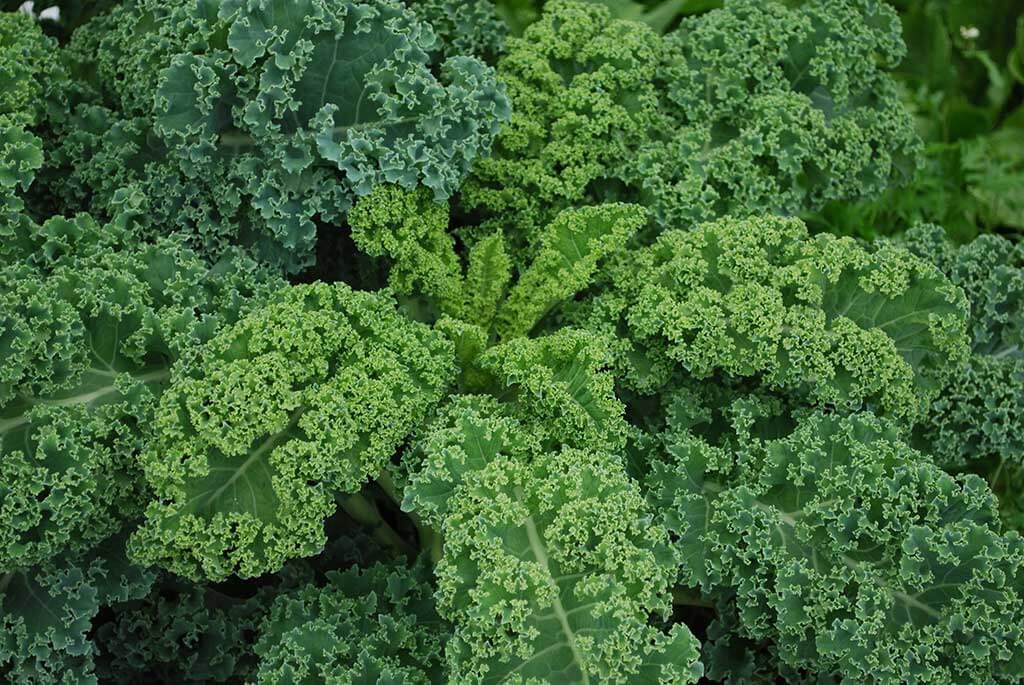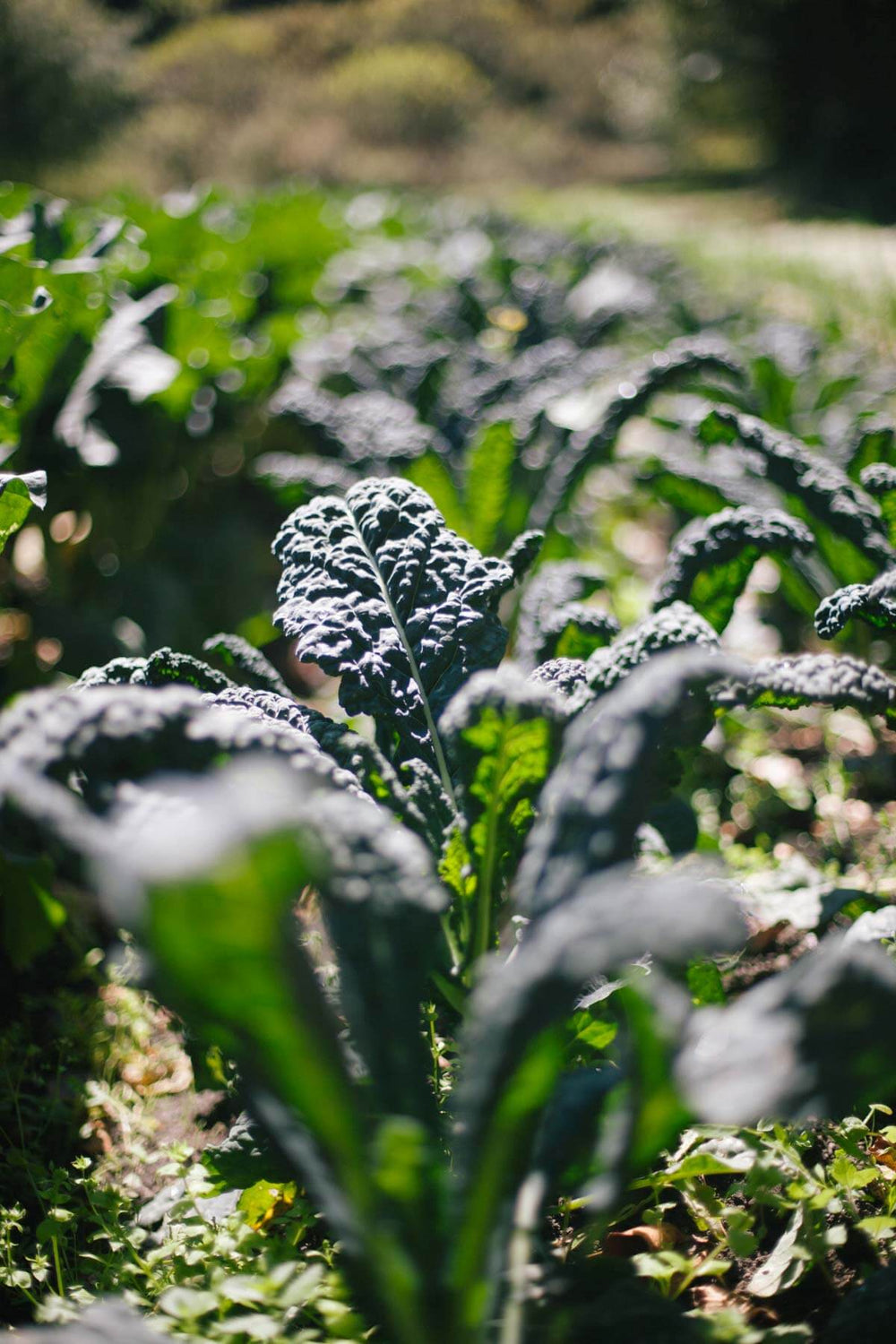Cold-hardy and resilient, kale is an easy member of the cabbage family to grow. You can set out plants quite early in spring as long as you protect the young plants from severe cold winds with a cover. They will grow steadily for months until the weather gets too warm. You'll get a second chance to plant kale in the fall, when cool weather brings out a wonderfully sweet, nutty flavor that is unique to these cold-natured plants.
Fall is the best time for growing kale in areas where winter doesn't dip below the teens, or in a cold frame farther north, because the leaves are sweeter when they mature in cooler weather. In the kitchen, kale can be steamed, stir-fried, or substituted for spinach in omelets, casseroles, or even quesadillas. It's a wonderful addition to smoothies, too, and tender young leaves make delicious salads.
Quick Guide to Growing Kale
- Plant kale 3 to 5 weeks before the last frost. In-ground gardens, raised beds, and containers are all excellent growing options.
- Space kale 18 to 24 inches apart in an area with full sun and well-drained, fertile soil with a pH of 6.5 to 6.8.
- Improve native soil by mixing in several inches of aged compost or other rich organic matter.
- Kale is a fast grower, so keep the soil moist by giving it 1 to 1.5 inches of water each week.
- Get the most out of your harvest by regularly feeding plants with a continuous-release plant food.
- For nutritious kale year-round, consider an indoor, water-based growing system.
- Harvest kale starting with the lowermost leaves once they reach the ideal color and are large enough to eat. Leaves reach their peak flavor once they've been kissed by a light frost.
Soil, Planting, and Care
Set out plants in spring 3 to 5 weeks before the last frost; in late summer, you can begin planting kale 6 to 8 weeks before the first frost for fall and winter harvests, and continue planting throughout the fall in zones 8, 9, and 10. Be sure to choose kale starter plants from Bonnie Plants®, so you know they'll be strong and vigorous.
Kale grows best in full sun, but will tolerate partial shade as well. Plants that receive fewer than 6 hours of sun daily will not be as stocky or leafy as those that get ample sun, but they will still be plenty edible! Like collards, kale likes fertile soil to grow fast and produce tender leaves. Enrich the soil with compost and fertilizer before setting out the seedlings. Apply fertilizer and lime according to test recommendations. If you forgo the soil test, work nitrogen-rich amendments such as blood meal, cottonseed meal, or composted manure into the ground before planting.
The soil pH should be 6.5 to 6.8 to discourage clubroot disease, although the plants will grow fine in a pH of 6.2 to 6.8 if clubroot is not a problem in your garden. To be sure about your soil pH, test the soil with a do-it-yourself kit, or by using your regional Cooperative Extension office. If that seems too complicated, you can simply improve your existing soil by mixing in a few inches of Miracle-Gro® Performance Organics®All Purpose In-Ground Soil with the top layer. Enriched with aged compost, it will improve both the texture and nutrition of the native soil.
Kale is easy to plant, and grows beautifully in both raised beds and containers. To create the ideal growing environment for the plant roots, fill raised beds with 100 percent organic Miracle-Gro® Raised Bed Soil and containers with Miracle-Gro® Performance Organics® All Purpose Container Mix. Set plants at the depth at which they are growing in the container. Space them 18 to 24 inches apart. The leaves will grow bigger if given a lot of space, but smaller leaves tend to be the most tender. After planting, water plants well. Plants grow best when they have access to both great soil and a continuous source of nutrition, so apply a water-soluble fertilizer such as Miracle-Gro® Performance Organics® Edibles Plant Nutrition regularly for excellent results.
At this point you may need to be patient, because spring-planted kale may stay small until slightly warmer soil temperatures trigger vigorous growth. Kale planted in late summer or early fall may sulk through spells of hot weather. Then, when conditions improve, the plants will take off, quickly multiplying in size.
Kale likes a nice, even supply of water, about 1 to 1.5 inches per week. You can measure how much water rain has provided by using a rain gauge in the garden. Mulch with compost, finely ground leaves, weed-free hay, straw, pine needles, or finely ground bark to keep the soil cool and moist and to keep down weeds. Mulching will also help keep the leaves free of splashing soil for a clean harvest.
You also have the option of growing kale indoors. An easy way to do that is in a hydroponic growing system like the Miracle-Gro® Twelve® Indoor Growing System. There's no soil—plants grow directly in water that circulates around the roots, delivering moisture, nutrition, and air. With plenty of light courtesy of a grow light, the system provides top-notch growing conditions for kale. Best of all, you won't even have to go outside to harvest.
Troubleshooting
Kale often grows as a carefree crop, but there are several insects that like kale as much as people do. Velvety green cabbageworms often can be found chewing holes in kale leaves. The larvae of cabbage white butterflies, cabbageworms are more likely to feed on cabbage, broccoli, and cauliflower than to bother your kale.
Colourful black-and-orange harlequin bugs often show up on kale plants that are feeling the stresses of old age. Rather than fight the harlequins, most gardeners pull up and compost old plants if it is mid- to late summer. In late summer, the best way to protect young seedlings from these and other pests (like grasshoppers) is to cover them with a row cover or some other lightweight fabric, such as wedding net (tulle). The covers can be removed in mid-fall, when pest populations usually drop dramatically.
Watch for outbreaks of gray-green cabbage aphids, which often gather in clusters within the folds of frilly kale leaves. Treat small problems with insecticidal soap. Pick off and discard badly infested leaves.
Harvest and Storage
Like collards, kale leaves are sweetest in the fall, after they've been touched by a light frost. Pick the oldest leaves from the lowest section of the plants, discarding those that appear yellowed or ragged. Pick your way up the stalk, taking as many leaves as you like, as long as you leave at least 4 leaves intact at each plant's top (or growing crown). Kale will produce new leaves all winter in zones 7 to 10. In climates where hard freezes are frequent, kale often survives winter with additional cold protection from thick mulch, row covers, or plastic tunnels. Overwintered plants will eventually bolt (producing yellow flowers) in spring, signaling that it's time to remove them and make room for other crops. Wash the leaves thoroughly and store them in a plastic bag. You can eat the stems or discard them—it's up to you. If you cook the kale, the stems will become more tender. Kale leaves will keep for several days in the fridge in a loose plastic produce bag.




FAQs
Should I harvest leaves when they are young or wait until they grow larger?
It depends. Young leaves work great for salads, but if you're planning to cook the greens, let leaves reach full size. Pick the largest leaves from the bottom and outside of the plant. Avoid picking or damaging the center of the plant where new leaves arise.
How long can I expect to harvest kale?
For many months. You can pick spring-planted kale all summer, but leaves may get tough and bitter when heat arrives. Quality improves again in fall and plants continue growing even winter in mild climates. Frost makes them taste sweeter, and plants are cold-hardy at least to the low 20s. The following spring, though, they will bolt. The same is true for fall-planted kale. Winterbor is an especially cold-hardy one that works well in cold weather. Gardeners in cold climates can enjoy it through winter in a cold frame.
Is there anything I can do to help kale leaves stay sweet?
Warm weather can make kale bitter and tough. While cool temperatures are the key to sweet leaves, you can help keep roots cool by mulching around plants. Making sure plants remain well watered also improves leaf flavor.
I picked kale last week and the patch still looks sparse. Is there anything I can do to jump-start growth?
Fertilize during the growing season for a steady supply of leaves. You can side dress plants with compost or blood meal, spray foliage with diluted fish emulsion, or water with a liquid fertilizer like Bonnie Herb & Vegetable Plant Food.
How long can I store harvested kale?
Kale stays crisp in the refrigerator for up to two weeks. Store it in an unsealed plastic bag with a damp paper towel.
Frost is predicted. Should I pick all the kale and store it?
Frost actually sweetens kale. This is the most cold-hardy of all vegetables and will take quite a few of the early frosts before a hard freeze, or "black frost" as it sometimes called, kills it in colder regions. In zones 7 and warmer it often continues to produce leaves all winter long.
Green worms are eating my kale. Can I spray anything that will kill the worms without hurting my family or pets?
Cabbage worm likes to eat kale. If you've noticed a white moth fluttering among the plants, that's the source of your worms. Spray kale with Bacillus thuringiensis (Bt) to control the worms. Bt doesn't affect humans or other wildlife. Bt targets worms, which die after ingesting it. After you spray Bt, worms may take a few bites from the leaves, but they'll stop feeding and die in a few days. Spray any time you spot the moths among plants.




 Herbs
Herbs
 Vegetables
Vegetables
 Fruit
Fruit
 Flowers
Flowers
 Succulents
Succulents


